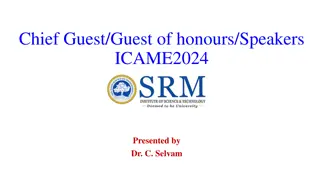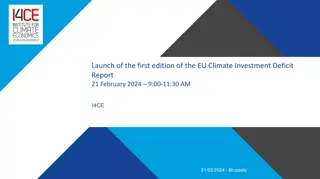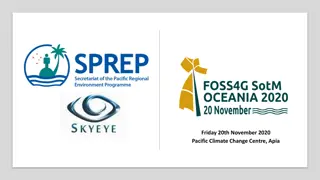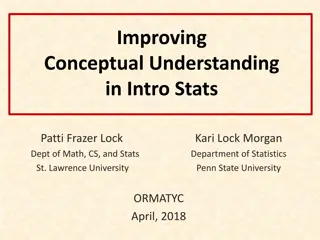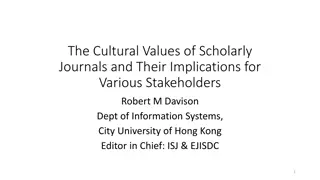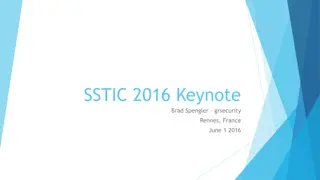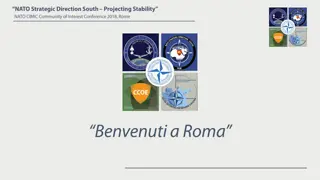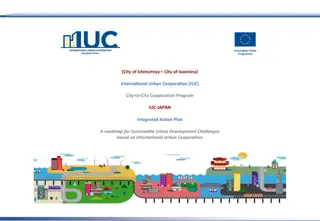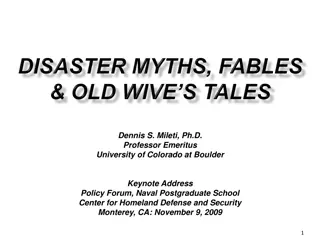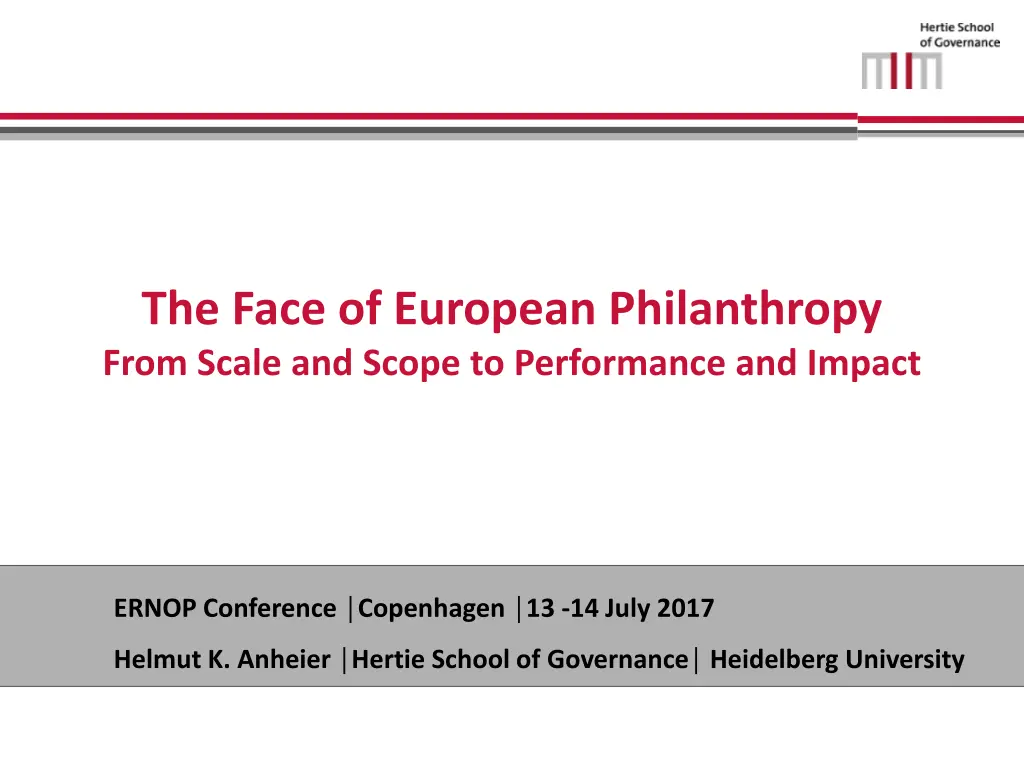
Understanding European Philanthropic Foundations: Insights and Perspectives
Explore the diverse landscape of European philanthropy, examining forms, roles, and contexts. Delve into the complexity of institutional maps and the significance of foundations within different countries, including Germany. Gain a deeper understanding of strategic philanthropy and its impact on a European scale.
Download Presentation

Please find below an Image/Link to download the presentation.
The content on the website is provided AS IS for your information and personal use only. It may not be sold, licensed, or shared on other websites without obtaining consent from the author. If you encounter any issues during the download, it is possible that the publisher has removed the file from their server.
You are allowed to download the files provided on this website for personal or commercial use, subject to the condition that they are used lawfully. All files are the property of their respective owners.
The content on the website is provided AS IS for your information and personal use only. It may not be sold, licensed, or shared on other websites without obtaining consent from the author.
E N D
Presentation Transcript
The Face of European Philanthropy From Scale and Scope to Performance and Impact ERNOP Conference Copenhagen 13 -14 July 2017 Helmut K. Anheier Hertie School of Governance Heidelberg University
Three arguments about foundations in Europe Diversity Form Size Behavior and Purpose Strategic philanthropy Alternative options Time & Scale Time-limited Smart pooling 2
Recall 1. Having mapped the institutional landscape of philanthropic foundations in terms of forms, numbers and size 2. Having examined the social and political history of philanthropy and its institutional forms across countries... 3. Having proposed classifications of philanthropy, mostly in the context of a larger nonprofit sector... And 4. Having come up with initial theories explaining variations in scale and scope... We approach the next set of tasks ...
Europe Multitude of foundation forms Models that go beyond charity/philanthropy/strategic philanthropy distinction Need to brand foundations as European institutions, not in reference to US gold standard Context specific developments (welfare states, nonprofit regimes, varieties of capitalism)
Institutional Map more complex for Europe State? Public? and? quasi-public? agencies? ? ? ? ? ? ? ? ? ? ? ? ? ? Fiduciary? founda ons? ? ? ? ? ? ? ? ? Corporate? founda ons? ? Philanthropic? founda ons? Nonprofit? corpora ons? ? ? ? ? and? associa ons? ? Civil? Society? ? ? ? Business? ? ? ? ? ? ? ? ? ? ? ? ? ? ? Anheier et al. 2017
Diversity across countries (Europe) Context Form Diversity Roles of Importance Foundations Social democratic Low Smaller Limited, stable Statist Low to medium Smaller Limited but growing Corporatist High Larger Significant Liberal Medium Larger Significant Mediterranian Medium Medium Less significant Post socialist Medium to high Smaller Limited but growing
Diversity within countries (Germany) Smaller endowments / expenditures Larger endowments / expenditures Approach Operating and mixed foundations Niche providers Services providers 29% of all foundations - 1% of expenditures 15% - 43% Grant-making foundations Engagement foundations Professional philanthropists 42% - 2% 14% - 54% Sample size = 1,004; total number of foundations in 2014 about 18,500 Small = Less than 100,000 spending annually Large = 100,000 plus spending annually Anheier et al. 2017
Small Foundations, Social implications About 18,800 private foundations (as of 2014) Three fourth (73%) founded after 1990 (ca. 13,700). About half 54% have budget of less than 50,000 Euro (ca. 10,200). Of which 84% are local (ca. 8,600). Which engage an estimated 56,000 volunteers These are on average connected to 231* people To create a network of 13 million people They offer the social glue of local middle class society (Mittelstand) impact and performance may be less important than the very fact of caring * Bernard-Killworth Median
Germany Only 1 in 10 has expenditure of more than 1 million; over half less than 50,000 Proportional approx. to population distribution Anheier et al. 2017
Similar in Switzerland Most foundations are small About one forth has endowments of 5 Mio. CHF, about 85% fewer than 5 Mio. CHF Eckhardt, Jakob & von Schnurbein 2014
UK About 63% of endowment in London Sector income and assets across regions, 2012/13 ( millions) 43% of UK charities have budgets of below 10k GBP, 71% of revenue concentrated in 1% Source: https://data.ncvo.org.uk/dataview/ income-assets-across-regions/
Argument I. Diversity Dometic form diversity to be more fully explored Most foundations are small, large foundations are few, very large ones even rare Some countries show geographical concentrations in terms of numbers and wealth Implications: role of donor and professionals may be different in highly concentrated foundation fields vs. smallness and localism Impact argument vs. civil society argument
Argument II. Behavior / Performance Performance and impact: for whom? As in the case of scale & scope, there is a US concentrated approach on performance measures and impact assessment - Strategic philanthropy - High impact or catalytic philanthropy - Etc. How relate to diversity of European experience?
Strategic Philanthropy The case for strategic philanthropy ultimately is based on the belief that the intentional, systematic, and rational pursuit of an outcome increases the chances of achieving it (Brest 2015). Underscoring this conviction is the use of terms like `flight plan and related imagery for describing the sequence of decisions and actions towards intended goals or results. Clear objectives; means-end relations; measurable performance criteria, milestones. Of relevance to larger foundations in professional fields.
Perhaps Smaller foundation may not want to be strategic, and do not have to, may not even know the term (73%!) Larger foundations often want to be strategic and may not know how to, some do. Perhaps all, could benefit from Hirschman s insight? Mangold 2017
Strategic Philanthropy Strategic philanthropy is a set of decisions and actions intended to achieve some desired outcomes under conditions of uncertainty and through ways and means that are beyond quick fixes and that require some level of flexibility, innovativeness, even creativity. If that were not the case, we would not have to be strategic in the first place and could apply standard operating procedures.
The Hiding Hand Hirschman argues that if planners or entrepreneurs had known in advance all the difficulties and troubles that were lying in store for a project, they probably would never have touched it. But why did they? That is where the principle of the Hiding Hand comes in: For Hirschman, by necessarily underestimating our creativity or resourcefulness ex ante, we may well underestimate to a roughly similar extent the difficulties of the tasks itself. In a way, we trick ourselves by these two offsetting underestimates into undertaking tasks which we can, but otherwise would not dare, tackle. Hirschman 1967
The Hiding Hand & Creative Philanthropy Creative Philanthropy kicks off a process towards some desired goal without fully knowing how to achieve it, nor knowing all consequences of intermediary steps or achieving the actual outcomes - we are letting ourselves be tricked by two similar offsetting underestimations: 1. That it can be done within our means and in known ways. 2. That it is not that difficult after all, that all can be achieved if only we are good at what we do. The dual independence of foundations from market considerations and the ballot box, gives them immense freedom to letting themselves being tricked. No dominant stakeholder keeps foundation ambitions in check and this is the source of their true resourcefulness and innovative potential. Anheier and Leat 2006
The Hiding Hand Could it be that some or perhaps many of the proud achievements of philanthropy were of this kind: taking on seemingly impossible tasks but believing they are achievable, while assuming that we have what it takes? Would Rockefeller have founded universities otherwise? Would RCT have engaged in the Northern Ireland Peace Process, Mercator in setting up a migration council, or KBF in a project to teach imams?
Complexity and Potential Underestimation Innovative Potential Overestimating Innovative Potential Underestimating Problems, Complexity of Tasks Required Tricked into action Self-confidence trickster Strategic Philanthropy Hype Philanthropy Overestimating Problems, Complexity of Tasks Required Missed opportunity Inexperience Timid Philanthropy Dilettante Philanthropy
Argument III. Time and Pooling Many small foundations, many getting smaller over time Is that not inefficient? Yes, options new and old to be explored: Pooling Time-limited
What are the issues? Long-standing debate around perpetuity Turgot s dead-hand problem (real estate, landed elite); anti-clerical elements, delivery failure Kant s principle of utility (feared obsolescence, state primacy in allocating foundations to best public use) ------------ Nielson: irremediable defect of being vulnerable to loss of spirit of first origin Prewitt: The enlightenment did not foster development of foundations
Underlying Issue Can private funds of considerable size serve public purposes better if donor intend can be changed in part or completely over time, even against the original stipulations of the deed? donors can decide on time horizons other than perpetuity, and change it over time? If so: who decides, regulates?
Current Issues Financial: Low interest, low inflation environment of 2010s versus high interest, high inflation environment of 1970s. Social Ecology: many new foundations being created, most rather small Large, visible foundations as spend-downs: US: Atlantic, Gates UK: 4-Acres, Princess Diana Fund Germany: Forced-Labor-Foundation, Mummert Stiftung
Underlying Issue Size: Efficiency: how to deal with growing numbers of smaller foundations that may not be well-managed (financial performance, governance), heading towards early obsolescence? Effectiveness: how can smaller foundations still achieve some impact (added value), also related to legitimacy? Donors (supply side): Some, perhaps more, donors prefer time-limited deeds Problems (demand side): Some problems require quicker, concentrated action, hence spending
Initial Impressions UK: some 20, ACF, some debate France: endowment funds next to foundations Germany: 2013 reform; limited number; some debate, mostly about tax Spain: no information Austria: exist, no data, no debate Sweden: no information, no debate Netherlands: no information, no debate Switzerland: do exist, great flexibility Belgium: some debate about KBF Italy: no information EU: European Foundation Statute allows it, unlikely to pass --------- Canada, Australia: exist, some debate
Differentiations cont. 1. Foundations established in perpetuity 2. Mixed foundations with permanent and flexible assets (note: flexible part can be spent and/or replenished) 3. Time-limited, spend-down foundation ( consumptive foundation, i.e. consumes its own assets while realizing deed / objectives) Conclusion time limited foundation adds goal & performance aspects next to sustainability principle / parallelism not yet settled
Three messages, by way of conclusion Let research agenda not be dominated by Grant-making foundation (consider variety of forms) Large foundations (consider smaller endowments) Foundations established as permanent entities (consider time-limitation)
Sources Anheier, H., F rster, S., Mangold, J., & Striebing, C. (2017). Stiftungen in Deutschland 1: Eine Verortung. Wiesbaden: Springer VS. Brest, P. (2015). Strategic Philanthropy and Its Discontents. Stanford Social Innovation Review. Retrieved from https://ssir.org/up_for_debate/article/strategic_philanthropy_and_its_discontents. Eckhardt, B., Jakob, D., & von Schnurbein, G. (2014). Der Schweizer Stiftungsreport 2014. Basel: CEPS, Centre for Philanthropy Studies, Universit t Basel. Hammack, D,. & Anheier, H. (2013). A Versatile American Institution: The Changing Ideals and Realities of Philanthropic Foundations. Washington, DC: Brookings. Hirschman, A. O. (1967). The Principle of the Hiding Hand , The Public Interest, 10-23. Kant, I. (1797): Die Metaphysik der Sitten. Retrieved from https://korpora.zim.uni-duisburg- essen.de/Kant/aa06/Inhalt6.html. Mangold, J. (2017). Strategische Philanthropie. In H. Anheier, S. F rster, J. Mangold, & C. Striebing (Eds.), Stiftungen in Deutschland 3: Portraits und Themen (pp. 93-108). Wiesbaden: Springer VS. Nielsen, W. (1996). Inside American Philanthropy. The Dramas of Donorship. Norman: University of Oklahoma Press. Prewitt, K., Dogan, M., Heydemann, S., & Toepler, S. (Eds.) (2006). The Legitimacy of Philanthropic Foundations: United States and European Perspectives. New York, NY: Russell Sage Foundation. Turgot, J. (2007). Endowments. In A. A. Kass (Ed.)., Giving well, doing good: readings for thoughtful philanthropists (pp. 333-338). Bloomington: Indiana University Press. 29



